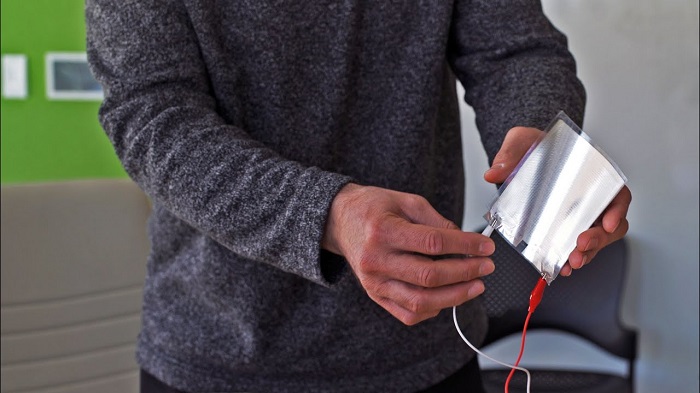ISABEL RUBIO ARROYO | Tungsteno
In addition to the fact that noise pollution can cause irreversible hearing damage, it also disturbs sleep and can affect the performance of schoolchildren. What if one of the solutions to prevent the harmful effects of noise on health were a speaker as thin as a piece of paper? That's what a team of scientists at the Massachusetts Institute of Technology (MIT) has come up with, a technology that can theoretically cancel out noise in homes, vehicles and even airplane cockpits. We analyse the potential uses of this remarkable new ultra-thin speaker.
A technology that gets rid of noise
"It feels remarkable to take what looks like a slender sheet of paper, attach two clips to it, plug it into the headphone port of your computer, and start hearing sounds emanating from it," says Vladimir Bulović, leader of MIT's Organic and Nanostructured Electronics Laboratory (ONE Lab) and lead author of the paper. In addition to the fact that this speaker can be used anywhere, it theoretically produces distortion-free sound and requires only "a smidgeon of electrical power to run." While this device only requires about 100 milliwatts of power per square metre of speaker area, a household device consumes on average more than 1 watt of power to generate similar sound pressure at a comparable distance, the researchers note.
Among the possible uses of this flexible loudspeaker, details of which have been reported in the scientific journal IEEE Transactions of Industrial Electronics, is noise cancellation. "By generating sound of the same amplitude but opposite phase, the two sounds cancel each other out," the MIT researchers write. A device capable of eliminating noise would be useful for preventing the harmful effects of noise pollution on health. At least 100 million people in the European Union are exposed to road traffic noise levels that scientists and health experts classify as unacceptable, according to a review published in the International Journal of Environmental Research and Public Health.
Noise pollution can also come from air traffic, recreation or construction sites. As indicated by the World Health Organization, noise can disturb sleep, cause hearing, cardiovascular and psychophysiological problems, reduce performance, and cause discomfort and changes in social behaviour. It can also affect the cognitive performance of schoolchildren.
One of the strengths of these ultra-thin, energy-efficient speakers, according to the researchers, is that they can be manufactured large enough to cover the interior of a car or airplane cabin or to wallpaper a room. But more research is still needed to determine the extent to which they would be useful in such contexts. At the moment, no details have been released on how such projects would be carried out, and it is unknown whether this technology will eventually be deployed in industrial or consumer applications.
The researchers say the loudspeaker emits sound with minimal distortion and requires little power to operate. Credit: MIT.
Reinventing ultra-thin speakers
Numerous researchers have been trying to create ultra-thin speakers for years. Most of these devices are generally free-standing, as the film must be able to bend freely to produce sound. But in many cases, mounting them on a surface can impede vibration and hinder their ability to generate sound. To get around this obstacle, the MIT team has rethought their design: instead of the entire material vibrating, the speaker they have created incorporates tiny domes on a thin layer of piezoelectric material, which each vibrate individually.
The domes are 15 microns high—about one-sixth the thickness of a human hair—and only move up and down about half a micron when they vibrate. Each one is a sound-generating unit, so it takes thousands of these tiny domes vibrating together to produce an audible sound. They are all surrounded by a system of layers that protect them from abrasion and possible everyday impacts.
Jinchi Han, MIT researcher and co-author of the study, says the process for making the speaker is simple and scalable. "It would allow us to produce these loudspeakers in a high-throughput fashion if we integrate it with a roll-to-roll process in the future," he says. This could prove useful for manufacturing this technology in large quantities, "like wallpaper to cover walls, cars, or aircraft interiors."
The speaker incorporates tiny domes on a thin layer of piezoelectric material that vibrate individually. Credit: MIT.
The potential of this type of ultra-thin speaker is immense. Ioannis Kymissis, a professor of electrical engineering at Columbia University, who was not involved in this research, predicts that this technology is "likely to lead to a range of new applications in speakers and microphones." In addition to combating noise pollution, this device could be used in the entertainment sector for immersive experiences, generating three-dimensional audio in a theatre or amusement park. Because it is so lightweight and requires so little power to operate, it could also be used in smart devices, whose batteries have a limited duration. Although the possibilities of these speakers are endless, we will still have to wait to see if they are mass-marketed or are just another experimental technology.
· — —
Tungsteno is a journalism laboratory to scan the essence of innovation. Devised by Materia Publicaciones Científicas for Sacyr’s blog.
